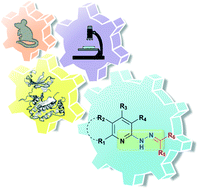A multicomponent pharmacophore fragment-decoration approach to identify selective LRRK2-targeting probes†‡
Abstract
Herein we report the development of a new versatile chemical tool for the rapid identification of LRRK2-targeting probes as potential anti-Parkinson's agents. Based on the structure of recently identified inhibitors, we decided to develop a new multicomponent approach to explore the biologically relevant space around their key pharmacophore fragment. The combination of organo/metal catalysis and microwave-assisted technology, allowed us to quickly generate highly functionalized heteroaryl-hydrazone derivatives for biological investigation. Enzymatic studies on the synthesized compounds allowed the identification of promising compounds endowed with a good LRRK2 specificity index (wt/G2019S activity ratio), low affinity towards a small panel of selected kinases and a mixed-type inhibition against the pathogenic G2019S mutant. These results show how a diversity-oriented approach based on a privileged pharmacophore fragment may play a key role in the identification of novel biologically relevant chemical probes.


 Please wait while we load your content...
Please wait while we load your content...